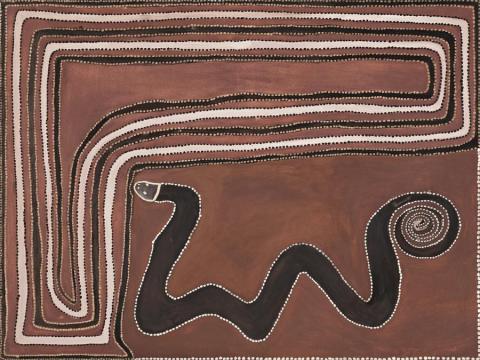GULABAL - SNAKE, 1989
ROVER THOMAS (JOOLAMA)
natural earth pigments and bush gum on canvas
120.0 x 160.0 cm
inscribed verso: artist's name and Waringarri Aboriginal Arts cat. AP3052 and S.2037
Waringarri Aboriginal Arts, Kununurra (label attached verso)
Deutscher Gertrude Street, Melbourne
Private collection, Melbourne, acquired from the above in 1989
Turkey Creek: Recent Work, Deutscher Gertrude Street, Melbourne, 25 October – 17 November 1989, cat. 11
Dreamtime Story of the Willy Willy, 1989, in the collection of the National Gallery of Victoria, illus. in Ryan, J., and Akerman, K., (eds), Images of Power: Aboriginal Art of the Kimberley, National Gallery of Victoria, Melbourne, 1993, p. 60
Gulabal -Snake, 1989, was painted in the year before Rover Thomas, along with Trevor Nickolls (1949 - 2012), became the first Aboriginal artists to represent Australia at the Venice Biennale. The painting displays the vitality and assurance of a painter at the peak of his career.
The work features a number of painterly elements that are characteristic of Rover Thomas's approach at the time. The white dots are made from huntite, a type of white chalky pigment. Huntite is used in ceremonial contexts and in rock art in the eastern Kimberley where it is applied raw (that is, with little or no fixative) in order to retain its elemental purity. Until about 1990, Rover Thomas applied the pigment in a similar way onto his canvases, where over time the huntite tends to absorb the resins in the surrounding or underlying paint, as is the case in this picture, especially in the black bands across the top and left. In the ground of the picture, Rover's application of paint is characteristically unpredictable "there are no lazy brush strokes" producing an animated surface where thin veils of colour jostle with densely-worked areas.
The painting was produced for Waringarri Arts in Kununurra in the eastern Kimberley which, in the late 1980s, was an agent for the artists of Warmun (Turkey Creek), 200 kilometres to the south. According to Waringarri's catalogue notes, Thomas has depicted the ancestor Gulabal in the form of a snake, against a ground representing sand. The ancestor lies beside a body of water that is bounded by a 'reef' or rocky outcrop. Nonetheless, the painting belies such a literal description. The ancestor has the power of metamorphosis, transforming its physical shape from that of a serpent to a man, then into a number of animal species, including a dog and pelican, before finally assuming the form of a woman. The notion of metamorphosis, of change, seems to be emphasised by the spiral of the sinuously drawn Snake's tail, which recalls the artist's renditions of the winds of Cyclone Tracy, the cataclysmic event that was to become Rover's Dreaming, the Kurirr Kurirr.
WALLY CARUANA
